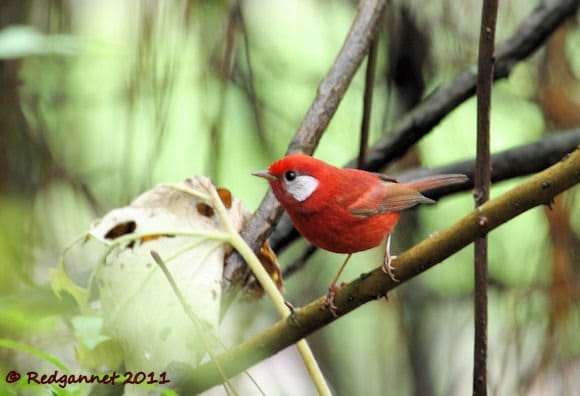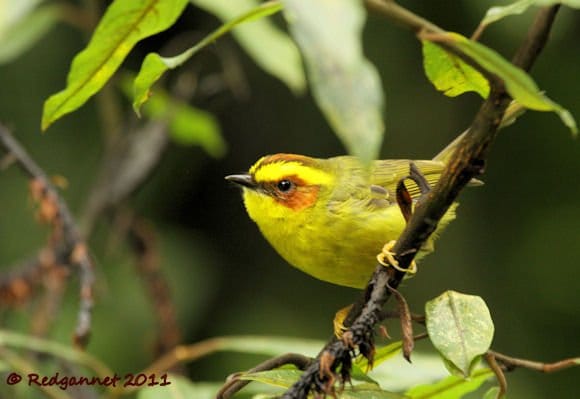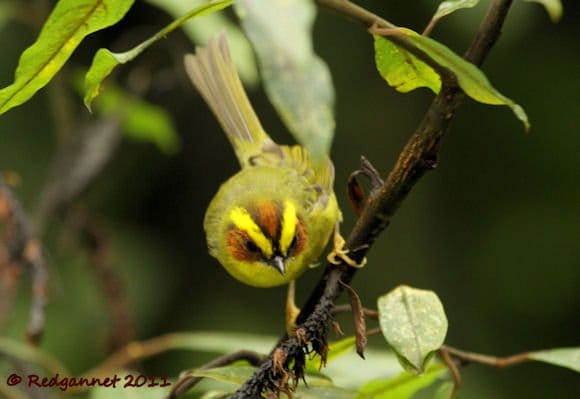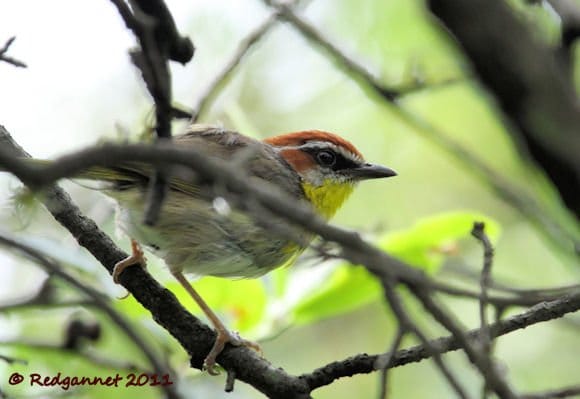I have taken refuge on the high ground as Irene batters the east coast of North America and Nanmadol swamps the Philipines, Taiwan and east China, but my thoughts and best wishes are with anyone who has been affected by the storms.
If Mexico City itself was not high enough, the mountains to the south rise above 12,300 feet and I was there looking for a Sierra Madre Sparrow to confirm a sighting of this rare and local sparrow from 15 years ago. Just to let you know, the sparrow did not show and I had to make do with some specialty Mexican warblers instead.
The Parulidae orgy that was ‘Wood-Warbler Week’ should have been enough to satisfy anyone’s dendroica lust, but I couldn`t help myself; just look at them!
First up we have the Red Warbler. This bird cannot resist a good ‘pish’ and was always the first to show when I tried to attract a passing party. Endemic to the Mexican mountains between 1800 and 3000 meters, the Red Warbler is a common and confiding bird of mixed pine and oak, or fir forests.
The Golden-browed Warbler is described as a skulker in Steve Howell and Sophie Webb’s ‘A Guide to the Birds of Mexico and Northern Central America’. In my limited experience, it is a bird that enjoys the high life and likes to party with the Red Warbler in the mountain forests.
The eponymous golden brows stand out like headlights in the gloom of the forest when the bird looks directly at you. It is not strictly endemic as it also occurs in Guatemala and Honduras.
The Rufous-capped Warbler has a hard staccato call that I initially mistook for a Rufous-capped Brush-finch. They look quite similar too at first glance, except for the white brow and rufous cheek of the warbler. It prefers scrub and secondary growth to the pine and evergreen forests and may be found from 3000m down as low as sea-level. This one was seen in a parque in Mexico City and I thought that it would be a lifer until I got home and found that the chestnut-capped form from Costa Rica was already on my list. It’s distribution is wider than that of the other two and it can even stray into the southernmost states of the USA on occasion.
As I write, Popacatapetl, the volcano 50 miles south-east of Mexico city, is grumbling outside the window. Is nowhere safe?

















That Red Warbler is one of my dream birds. What a stunner!
Beautiful warblers and wonderful photos.
Wow, that Red Warbler is gorgeous.
My retinas might never recover.
Red Warbler. I want it. Now.
Nice post on some of those delightful Mexican warblers. Love those Red Warblers! What makes them even nicer is that unlike the equally stunning Pink-headed Warbler, they are pretty easy to see in just about any highland pine forest in their range.
These warblers are stunners!
Pat, your comment makes me think of my first encounter with some of these Chiapas Highlands warblers. My last time in Guatemala, I glimpsed and then proceeded to ignore the ravishing Red-faced Warbler because a Pink-headed Warbler flew into view. I’d probably do the same to a Red Warbler.
@ Pat,
yes indeed, they were all very confiding and pish-prone. My only regret was not getting a nice look at the dozen or so Olive Warblers that were part of the many feeding flocks that I came across. It may not be as flashy, but the Olive Warbler has an understated sophistication that I just adore.
If anybody wanna visit Mexico for an amazing birding time, Nevado de Toluca National Park is one of the best choices for you. Continental airlines have an amazing flight price 400, round trip houston-toluca.
I will be doing a bird fest with Environment for the Americas, December the 3th. Here you have some interesting species you will find:
Sialia mexicana
Catharus occidentalis
Catharus guttatus
Turdus migratorius
Ergaticus ruber
Dendroica coronata
Dendroica fusca
Geothlypis trichas
Oporornis tolmei
Vermivora crissalis
Vermivora ruficapilla
Vermivora celata
Wilsonia pusilla
Myioborus miniatus
Carpodacus mexicanus
Carduelis psaltria
Mimus gilvus
Toxostoma curvirostre
Pheucticus melanocephalus
Pipilo erythrophthalmus macronyx
Oritorus superciliosus
Junco phaenotus
Atlapetes pileatus
Buarremon virenticeps
Xenospiza baileyi
Chondestes grammacus
Melospiza lincolnii
Melospiza melodia
Euphonia elegantisima